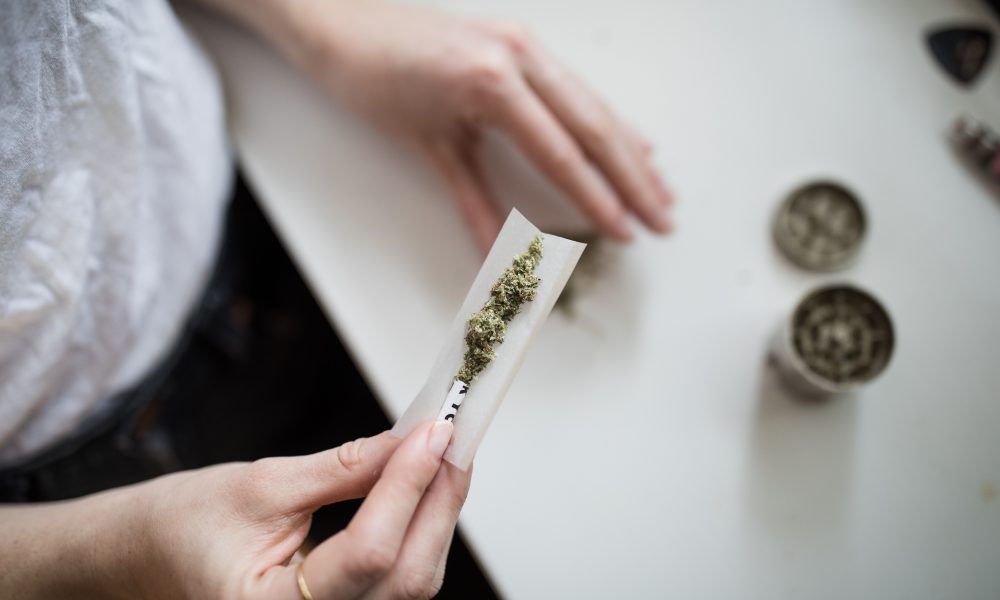With little more than a week before Election Day in Ohio, two new polls indicate that a comfortable majority of voters support legalizing adult-use marijuana—the subject Issue 2 on the state ballot.
A survey of 638 Ohio voters by Public Policy Polling found that 59 percent of respondents would vote yes on Issue 2, while 39 percent would vote against it. Just 2 percent were undecided.
A separate poll from Northern Ohio University, meanwhile, found that two out of three voters support legalizing marijuana generally—though the survey didn’t specifically ask about Issue 2. Questions about cannabis in that survey were limited to use and attitudes toward the drug and policies surrounding it generally.
Pollsters behind the Northern Ohio University survey said the findings nevertheless bode well for Issue 2.
“There has been a rapid rise in the legalization of recreational marijuana across the country and Ohio appears poised to become the next state to legalize it given attitudes we are seeing about the use of recreational marijuana in the state,” Robert Alexander, a political science professor and the founding director of the Institute for Civics and Public Policy at Ohio Northern University.
On legalization, only 8 percent of all respondents said cannabis should be prohibited entirely. Almost a quarter (23 percent) said it should be legal for medical use only. Most (66 percent) said it should be legal for both medical and recreational use.
Opinions on adult-use legalization especially differed sharply by party. Among Democrats or those who lean Democrat, 82 percent said they support recreational legalization. On the other side, 48 percent of Republican or Republican-leaning voters favored legalization.
Support for adult-use and medical marijuana was nevertheless the plurality position among GOP voters. Another 35 percent said cannabis should be legal only for medical use, while 12 percent said it should be illegal for all uses.
The Northern Ohio University poll also asked about marijuana use and social attitudes toward cannabis. Majorities of voters on the left (74 percent) and right (60 percent) said they’d used cannabis.
Overall, two thirds of respondents (67 percent) said they’d used marijuana, while 31 percent said they hadn’t. Another 13 percent said they weren’t comfortable answering the question. Among people who use marijuana, the two most common answers when asked about frequency were “rarely” (50 percent) and daily (29 percent).
Unsurprisingly given those findings, most people also know others who use cannabis. Asked how many of their friends and family members consume, 32 percent said some do, 23 percent said most, 22 percent said very few and 18 percent said no one uses it. Five percent said they weren’t sure.
Forty-one percent of respondents said they think “using marijuana openly” is socially acceptable, 31 percent said it was tolerable and 24 percent said it was unacceptable.
The poll also asked about people’s opinions of others’ who use marijuana. If a friend or family member used cannabis, 82 percent of respondents said it would not change their opinion of that person. Only 9 percent of respondents said they would think less of the person, while 5 percent said they would think better of them.
“Although there is a lot of discussion about the legalization of marijuana in the state, we know surprisingly little about current marijuana usage and perceptions around it,” Alexander, who co-led the survey, noted in a statement accompanying the results. “Our findings suggest that most people have used it, some use it a lot, and most people are pretty accepting of marijuana use.”
Perhaps reassuring to employers, 84 percent of those surveyed said they use cannabis only after work. Six percent said they do it before work, and 2 percent said they consume before and after work. Another 8 percent said at least some of their cannabis use occurs during work hours.
The survey of 668 registered voters, conducted in collaboration with the polling firm Lucid, ran October 16–19 and has an overall margin of error of 3.8 percent, although the margins of error varied for individual responses.
Other recent surveys of Ohio voters and lawmakers also suggest Issue 2 has a good chance at passage. A separate survey of likely voters published earlier this month found that 57 percent supported the legalization measure, including a slim majority of Republicans.
Another survey of 35 state lawmakers found that majorities of both Democrats (63 percent) and Republicans (52 percent) expected voters to approve the measure.
But while Ohio lawmakers might expect the initiative to pass, many Republican elected officials don’t want it to. As early voting kicked off this month, the GOP-controlled Senate passed a resolution urging residents to reject measure.
Here are the key provisions of the legalization ballot measure on the November 7 ballot:
- The initiative would legalize possession of up to 2.5 ounces of cannabis for adults 21 and older, and they could also have up to 15 grams of marijuana concentrates.
- Individuals could grow up to six plants for personal use, with a maximum 12 plants per household.
- A 10 percent sales tax would be imposed on cannabis sales, with revenue being divided up to support social equity and jobs programs (36 percent), localities that allow adult-use marijuana enterprises to operate in their area (36 percent), education and substance misuse programs (25 percent) and administrative costs of implementing the system (three percent).
- A Division of Cannabis Control would be established under the state Department of Commerce. It would have authority to “license, regulate, investigate, and penalize adult use cannabis operators, adult use testing laboratories, and individuals required to be licensed.”
- The measure gives current medical cannabis businesses a head start in the recreational market. Regulators would need to begin issuing adult-use licenses to qualified applicants who operate existing medical operations within nine months of enactment.
- The division would also be required to issue 40 recreational cultivator licenses and 50 adult-use retailer licenses “with a preference to applications who are participants under the cannabis social equity and jobs program.” And it would authorize regulators to issue additional licenses for the recreational market two years after the first operator is approved.
- Individual municipalities would be able to opt out of allowing new recreational cannabis companies from opening in their area, but they could not block existing medical marijuana firms even if they want to add co-located adult-use operations. Employers could also maintain policies prohibiting workers from consuming cannabis for adult use.
- Further, regulators would be required to “enter into an agreement with the Department of Mental Health and Addiction Services” to provide “cannabis addiction services,” which would involve “education and treatment for individuals with addiction issues related to cannabis or other controlled substances including opioids.”
- With respect to social equity, some advocates are concerned about the lack of specific language on automatic expungements to clear the records of people with convictions for offenses that would be made legal under the legislation. That said, the measure does include a provision requiring regulators to “study and fund” criminal justice reform initiatives including expungements.
Among Republicans, state Sen. Mark Romachuk (R) has warned that passing Issue 2 would lead to more problems for children, on roadways and at work. “This creates challenges to maintaining safe workplaces, especially in industries that require high alertness and precision like Ohio’s manufacturing businesses,” he said, according to local media reports. Romachuk also criticized the initiative’s proposed 10 percent tax as too low.
If the measure does pass, Senate President Matt Huffman (R) said earlier this month, it’s “coming right back before this body” for lawmakers to amend. Huffman later clarified that he wouldn’t seek to repeal the legalization plan entirely but would instead “advocate for reviewing it and repealing things or changing things that are in it.”
A number of Ohio lawmakers said last month that they doubted the legislature would seek to repeal a voter-passed legalization law. “There are not a majority of legislators in both chambers that would be pro-repeal,” Rep. Ron Ferguson (R) told The Dispatch. “You would have no Democrats, and there are not enough Republicans to put them in the top.”
Both sides of the campaign have been stepping up messaging and get-out-the-vote efforts as the election draws nearer. Earlier this month, the yes campaign sent cease and desist letters to TV stations airing what organizers called opposition advertisements “filled with lies.” And the Campaign to Regulate Marijuana Like Alcohol put out a pro-Issue 2 election ad of its own.
Last week, the yes campaign put out another ad, which mocks Ohio from the perspective of a neighboring Michigan town for losing tax revenue when Ohioans drive across state borders to buy marijuana from licensed stores.
The ad came days after a new economic analysis found that Issue 2 would likely produce around $260 million in net benefits to the state on an annual basis.
“Our simulation model suggests that in 90 percent of likely scenarios, recreational marijuana legalization will have a positive net economic benefit on society,” that report said. The modeling also predicted that “extremely positive results are more likely than extremely negative results.”
A separate analysis published in August by Ohio State University researchers found the change could bring in $404 million in annual tax revenue.
Attorney General Dave Yost (R), meanwhile, published an analysis of the initiative that he said is meant to provide voters with “vital clarity and transparency” amid a campaign that has seen “inflamed and inaccurate” rhetoric.
Despite the GOP-led resolution, other Republicans officials in Ohio remain divided on the issue. Gov. Mike DeWine (R) has said he believes “it would be a real mistake for us to have recreational marijuana,” adding that he visited Colorado following its move to legalize in 2012 and saw what he described as an “unmitigated disaster.”
Sen. John Hickenlooper (D-CO), who was Colorado’s governor in 2012, said last year, however, that while he was initially concerned that legalization would encourage more use by young people, he came to believe those worries were unfounded.
“I think we’ve proven and demonstrated that there is no increase in experimentation among teenagers. There is no change in frequency of use, no change in driving while high,” Hickenlooper said. “All the things we most worried about didn’t come to pass.”
Unlike the top state Republican lawmakers, one of the state’s GOP representatives in Congress—Rep Dave Joyce, co-chair of the Congressional Cannabis Caucus, said last month that he’ll be voting in favor of the initiative in November. He encouraged “all Ohio voters to participate and make their voices heard on this important issue.”
The Ohio Ballot Board approved summary language for the legalization measure in August.
Ohio voters rejected a 2015 measure, on a 64–36 vote, that would have amended the state’s constitution to legalize marijuana and give control of the market to a small group of producers. Organizers for the current campaign said they drew on lessons learned from that failure in crafting the current initiative.
If the initiative becomes law, it would bring the total number of states with adult-use legalization to 24.
Bipartisan Ohio lawmakers filed a separate bill to legalize marijuana in May, offering the legislature another opportunity to take the lead on the reform. But it has yet to advance, and now the stage is set for voters to make the choice.
Ohio Ballot Measure To Legalize Marijuana Won’t Automatically Expunge Prior Convictions
Read the full article here









